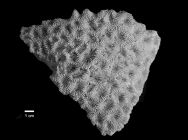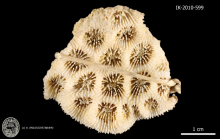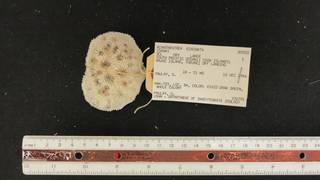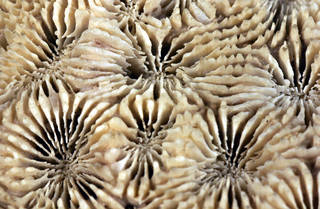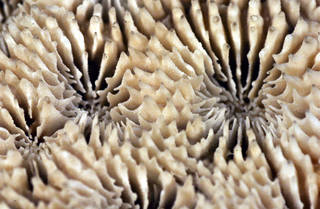WoRMS taxon details
Acanthastrea echinata (Dana, 1846)
207384 (urn:lsid:marinespecies.org:taxname:207384)
accepted
Species
Acantastrea echinata (Dana, 1846) · unaccepted > misspelling - incorrect subsequent spelling
Acanthastraea echinata (Dana, 1846) · unaccepted > misspelling - incorrect subsequent spelling
Acanthastraea echinata var. pseudofavites Chevalier, 1975 · unaccepted > junior subjective synonym
Acanthastraea echinata var. tenuisepta Chevaiier, 1975 · unaccepted > junior subjective synonym
Acanthastraea grandis Milne Edwards & Haime, 1849 · unaccepted > junior subjective synonym
Acanthastraea hirsuta Milne Edwards & Haime, 1857 · unaccepted > junior subjective synonym
Acanthastrea grandis Milne Edwards & Haime, 1849 · unaccepted > junior subjective synonym
Acanthastrea hirsuta Milne Edwards & Haime, 1857 · unaccepted > junior subjective synonym
Acanthastrea hirsuta var. megalostoma Klunzinger, 1879 · unaccepted > junior subjective synonym
Acanthastrea spinosa Milne Edwards & Haime, 1848 · unaccepted > junior subjective synonym
Astraea (Fissicella) echinata Dana, 1846 · unaccepted > superseded combination (basionym)
Astraea echinata Dana, 1846 · unaccepted > superseded combination (incorrect genus spelling)
Astrea echinata Dana, 1846 · unaccepted > superseded combination
Favia hirsuta (Milne Edwards & Haime, 1857) · unaccepted > junior subjective synonym
Favites hirsuta (Milne Edwards & Haime, 1857) · unaccepted > junior subjective synonym
Prionastraea echinata (Dana, 1846) · unaccepted > superseded combination
Prionastraea hirsuta (Milne Edwards & Haime, 1857) · unaccepted > junior subjective synonym
Prionastrea echinata (Dana, 1846) · unaccepted > superseded combination
marine, fresh, terrestrial
(of Astraea (Fissicella) echinata Dana, 1846) Dana, J.D. (1846-1849). Zoophytes. United States Exploring Expedition during the years 1838-1842. <em>Lea and Blanchard, Philadelphia.</em> 7: 1-740, 61 pls. (1846: 1-120, 709-720; 1848: 121-708, 721-740; 1849: atlas pls. 1-61)., available online at http://www.sil.si.edu/digitalcollections/usexex/navigation/ScientificText/USExEx19_08select.cfm [details] 
Type locality contained in Fijian Exclusive Economic Zone
, Note Fiji (Veron, 1986).
type locality contained in Fijian Exclusive Economic Zone [details]
Unreviewed
Type locality Fiji (Veron, 1986). [details]
Description This species has calices whose diameters vary widely between about 10-25 mm. It has thickened septa with strong spines....
Description This species has calices whose diameters vary widely between about 10-25 mm. It has thickened septa with strong spines. Superficially, A. echinata is of similar shape and size as some Favites species, particularly F. complanata or F. flexuosa, but the spines are considerably thicker and sharper than in the latter genus. In addition, the living coral has a thick layer of fleshy tissue as is typical for mussids. The living colour is usually reddish brown, sometimes with green patches. This is a common species, especially in shallow water. Its habitats include crevices on exposed reef crests, down to 45 m depth, and in turbid water. It is thus very tolerant of a wide range of environments (Sheppard, 1998 <308>).
Corallites are cerioid or subplocoid, circular, with thick walls. When retracted, polyps have thick concentric folds. Colour: uniform dull brown, grey or green. Abundance: Common over a wide range of habitats. Rarely occurs over 1 m in diameter. (Veron, 1986 <57>)
All species of this genus have large, fleshy polyps and, when contracted, they have concentric folds. They form flat, dome-shaped colonies with a coarse honey-comb pattern. The septo-costae are toothed. Colour: varies from brown to grey or green, usually green oral discs. Habitat: diverse reef areas. (Richmond, 1997) [details]
Corallites are cerioid or subplocoid, circular, with thick walls. When retracted, polyps have thick concentric folds. Colour: uniform dull brown, grey or green. Abundance: Common over a wide range of habitats. Rarely occurs over 1 m in diameter. (Veron, 1986 <57>)
All species of this genus have large, fleshy polyps and, when contracted, they have concentric folds. They form flat, dome-shaped colonies with a coarse honey-comb pattern. The septo-costae are toothed. Colour: varies from brown to grey or green, usually green oral discs. Habitat: diverse reef areas. (Richmond, 1997) [details]
Hoeksema, B. W.; Cairns, S. (2024). World List of Scleractinia. Acanthastrea echinata (Dana, 1846). Accessed through: World Register of Marine Species at: https://www.marinespecies.org/aphia.php?p=taxdetails&id=207384 on 2024-11-21
Date
action
by
![]() The webpage text is licensed under a Creative Commons Attribution 4.0 License
The webpage text is licensed under a Creative Commons Attribution 4.0 License
original description
(of Acanthastrea spinosa Milne Edwards & Haime, 1848) Milne Edwards, H.; Haime, J. (1848). Note sur la classification de la deuxième tribu de la famille des Astréides. <em>Comptes rendus hebdomadaires des séances de l'Académie des sciences, Paris.</em> 27: 490–497., available online at https://doi.org/10.5962/bhl.part.29692 [details]
original description (of Acanthastrea hirsuta Milne Edwards & Haime, 1857) Milne Edwards H, Haime J. (1857). Histoire naturelle des coralliaires ou polypes proprement dits 2. Librairie Encyclopédique de Roret, Paris. 631 pp., available online at https://www.biodiversitylibrary.org/page/12403706 [details]
original description (of Acanthastrea grandis Milne Edwards & Haime, 1849) Milne Edwards H, Haime J. (1849). Recherches sur les polypiers. Mémoire 4. Monographie des Astréides (1) (suite). <em>Annales des Sciences Naturelles, Zoologie, Series 3.</em> 12, 3, 95-197. [details]
original description (of Astraea (Fissicella) echinata Dana, 1846) Dana, J.D. (1846-1849). Zoophytes. United States Exploring Expedition during the years 1838-1842. <em>Lea and Blanchard, Philadelphia.</em> 7: 1-740, 61 pls. (1846: 1-120, 709-720; 1848: 121-708, 721-740; 1849: atlas pls. 1-61)., available online at http://www.sil.si.edu/digitalcollections/usexex/navigation/ScientificText/USExEx19_08select.cfm [details]
original description (of Acanthastrea hirsuta var. megalostoma Klunzinger, 1879) Klunzinger CB. (1879). Die Korallthiere des Rothen Meeres, 2. Theil: Die Steinkorallen. Erster Abschnitt: Die Madreporaceen und Oculinaceen. <em>Gutmann, Berlin.</em> pp. 1-88, pls. 1-10. [details]
original description (of Favites hirsuta (Milne Edwards & Haime, 1857)) Milne Edwards H, Haime J. (1857). Histoire naturelle des coralliaires ou polypes proprement dits 2. Librairie Encyclopédique de Roret, Paris. 631 pp., available online at https://www.biodiversitylibrary.org/page/12403706 [details]
original description (of Acanthastraea echinata var. tenuisepta Chevaiier, 1975) Chevalier JP. (1975). Les Scléractiniaires de la Mélanésie Française (Nouvelle-Caledonie, Iles Chesterfield, Iles Loyauté, Nouvelles Hébrides). II. Expedition Française sur les Récifs Coralliens Nouv.-Calédonie. 7: 1-407, pls. 1-42. Paris. [details]
original description (of Acanthastraea echinata var. pseudofavites Chevalier, 1975) Chevalier JP. (1975). Les Scléractiniaires de la Mélanésie Française (Nouvelle-Caledonie, Iles Chesterfield, Iles Loyauté, Nouvelles Hébrides). II. Expedition Française sur les Récifs Coralliens Nouv.-Calédonie. 7: 1-407, pls. 1-42. Paris. [details]
context source (HKRMS) Chan, A. L. K.; Chan, K. K.; Choi, C. L. S.; McCorry, D.; Lee, M. W.; Ang, P. (2005). Field guide to hard corals of Hong Kong. <em>Agriculture, Fisheries and Conservation Department, The Hong Kong SAR Government.</em> [details]
context source (Hexacorallia) Fautin, Daphne G. (2013). Hexacorallians of the World. (look up in IMIS) [details]
basis of record Veron JEN. (1986). Corals of Australia and the Indo-Pacific. <em>Angus & Robertson Publishers.</em> [details]
additional source Cairns, S.D., B.W. Hoeksema & J. van der Land. (1999). Appendix: List of extant stony corals. <em>Atoll Research Bulletin.</em> 459: 13-46.
page(s): 34 [details]
additional source Randall RH. (2003). An annotated checklist of hydrozoan and scleractinian corals collected from Guam and other Mariana Islands. <em>Micronesica.</em> 35-36: 121-137.
page(s): 134 [details]
additional source Cairns, S.D., B.W. Hoeksema & J. van der Land. (2007). as a contribution to UNESCO-IOC Register of Marine Organisms. (look up in IMIS) [details]
additional source Liu, J.Y. [Ruiyu] (ed.). (2008). Checklist of marine biota of China seas. <em>China Science Press.</em> 1267 pp. (look up in IMIS) [details] Available for editors [request]
[request]
additional source Veron JEN, Pichon M. (1980). Scleractinia of Eastern Australia – Part III. Family Agariciidae, Siderastreidae, Fungiidae, Oculinidae, Merulinidae, Mussidae, Pectinidae, Caryophyllidae, Dendrophylliidae. <em>Australian Institute of Marine Science Monograph Series.</em> 4: 1-459. [details]
additional source Veron JEN. (2000). Corals of the World. Vol. 1–3. <em>Australian Institute of Marine Science and CRR, Queensland, Australia.</em> [details]
additional source Veron JEN. (2002). New species described in Corals of the World. <em>Australian Institute of Marine Science Monograph Series.</em> 11: 1-209.
page(s): 128, 129 [details]
additional source Wells JW. (1955). Recent and subfossil corals of Moreton Bay, Queensland. <em>Queensland. University of Queensland Papers, Department of Geology.</em> 4 (10): 1-18, pls. 1-3.
page(s): 15, 16 [details]
additional source Yabe H, Sugiyama T, Eguchi M. (1936). Recent reef-building corals from Japan and the South Sea Islands under the Japanese mandate. I. <em>The Science reports of the Tôhoku Imperial University, Sendai, 2nd Series (Geologie).</em> Special Volume 1: 1-66, pls. 1-59.
page(s): 4, 47, Pl. XXXIV [details]
additional source Yabe H, Sugiyama T. (1935). Revised list of the reef-corals from the Japanese seas and of the fossil reef corals of the raised reefs and the Ryukyu limestone of Japan. <em>Journal of the Geological Society of Japan.</em> 42: 379-403.
page(s): 384, 389, 395 [details]
additional source Hodgson G, Ross MA. (1982). Unreported scleractinian corals from the Philippines. <em>Proceedings of the Fourth International Coral Reef Symposium, Manila, 1981.</em> 2: 171-175.
page(s): 171 [details]
additional source Pillai CSG, Scheer G (1976) Report on the stony corals from the Maldive Archipelago. Results of the Xarifa Expedition 1957/58. Zoologica, Stuttgart 43 (126): 1-83, pls. 1-32. [details]
additional source Crossland C (1952) Madreporaria, Hydrocorallinae, Heliopora and Tubipora. Scientific Report Great Barrier Reef Expedition 1928-29 VI(3): 85-257.
page(s): 91, 141 [details]
additional source Nemenzo F, Hodgson G (1983) Philippine scleractinian corals – additional records. Philippine Journal of Science 112: 29-55.
page(s): 31, 42, 63 [details]
additional source Pichon, M.; Benzoni, F. (2007). Taxonomic re-appraisal of zooxanthellate Scleractinian Corals in the Maldive Archipelago. <em>Zootaxa.</em> 1441: 21–33.
page(s): 32 [details]
additional source Huang D, Arrigoni R, Benzoni F, Fukami H, Knowlton N, Smith ND, Stolarski J, Chou LM, Budd AF. (2016). Taxonomic classification of the reef coral family Lobophylliidae (Cnidaria: Anthozoa: Scleractinia). <em>Zoological Journal of the Linnean Society.</em> 178(3): 436-481., available online at https://doi.org/10.1111/zoj.12391 [details]
additional source Veron JEN, Marsh LM. (1988). Hermatypic corals of Western Australia : records and annotated species list. <em>Records Western Australian Museum Supplement.</em> 29: 1-136., available online at https://doi.org/10.5962/bhl.title.60555
page(s): 25, 92 [details]
additional source Pillai CSG. (1972). Stony corals of the seas around India. <em>Proceedings of the First International Symposium on Corals and Coral Reefs, 1969. Marine Biological Association of India Symposium.</em> 5: 191-216.
page(s): 209 [details]
additional source Randall RH, Myers RF. (1983). The corals. Guide to the Coastal Resources of Guam: Vol. 2. <em>University of Guam Press, Guam, pp. 128.</em> [details]
additional source Veron, J. E. N. (2000). Corals of the World, Volume III: Families Mussidae, Faviidae, Trachyphylliidae, Poritidae. Australian Institute of Marine Science. Townsville., volume 3, pp. 490.
page(s): 18 [details]
additional source Maragos, J. E.; Kenyon, J. (2004). Rose Atoll coral data compiled from US Fish and Wildlife Service 1994, Townsend Cromwell 2002, and Sette 2004 surveys [Table 10]. UNPUBLISHED, Unpublished
page(s): 1 [details]
additional source Maragos, J. E. (2004). Baker Island coral data [Table unnumbered]. UNPUBLISHED, Unpublished
page(s): 1 [details]
additional source Wells JW. (1954). Recent corals of the Marshall Islands: Bikini and nearby atolls, part 2, oceanography (biologic). <em>U.S. Geological Survey Professional Paper.</em> 260(I): 385-486.
page(s): 394, 467 [details]
additional source Pillai CSG. (1983). Structure and generic diversity of recent Scleractinia of India. <em>Journal of the Marine Biological Association of India.</em> 25, 1-2, 78-90.
page(s): 88 [details]
additional source Veron, J. E. N.; Pichon, M. (1979). Scleractinia of Eastern Australia, part III: Families Agariciidae, Siderastreidae, Fungiidae, Oculinidae, Merulinidae, Mussidae, Pectiniidae, Caryophylliidae, Dendrophylliidae. Australian Government Publishing Service. Canberra., volume 4, pp. 422.
page(s): 7, 253-257 [details]
additional source Sheppard, C. R. C. (1985). Fringing reefs in the southern region, Jeddah to Jizan. Fauna of Saudi Arabia, 7, 37-58
page(s): 46 [details]
additional source Kühlmann, D. H. H. (2006). Die Steinkorallensammlung im Naturhistorischen Museum in Rudolstadt (Thüringen) nebst ökologischen Bemerkungen. Rudolstädter Naturhistorische Schriften, 13, 37-113
page(s): 63, 98, 111 [details]
additional source Wallace, C. C.; Fellegara, I.; Muir, P. R.; Harrison, P. L. (2009). The scleractinian corals of Moreton Bay, eastern Australia: high latitude, marginal assemblages with increasing species richness. Memoirs of the Queensland Museum, 54, 2
page(s): 3, 11, 14, 22, 87, 89 [details]
new combination reference Vaughan TW. (1918). Some shallow-water corals from Murray Island (Australia), Cocos-Keeling Island, and Fanning Island. <em>Papers from the Department of Marine Biology of the Carnegie Institution of Washington.</em> 9 (213): 49-234, pls. 20-93. [details]
original description (of Acanthastrea hirsuta Milne Edwards & Haime, 1857) Milne Edwards H, Haime J. (1857). Histoire naturelle des coralliaires ou polypes proprement dits 2. Librairie Encyclopédique de Roret, Paris. 631 pp., available online at https://www.biodiversitylibrary.org/page/12403706 [details]
original description (of Acanthastrea grandis Milne Edwards & Haime, 1849) Milne Edwards H, Haime J. (1849). Recherches sur les polypiers. Mémoire 4. Monographie des Astréides (1) (suite). <em>Annales des Sciences Naturelles, Zoologie, Series 3.</em> 12, 3, 95-197. [details]
original description (of Astraea (Fissicella) echinata Dana, 1846) Dana, J.D. (1846-1849). Zoophytes. United States Exploring Expedition during the years 1838-1842. <em>Lea and Blanchard, Philadelphia.</em> 7: 1-740, 61 pls. (1846: 1-120, 709-720; 1848: 121-708, 721-740; 1849: atlas pls. 1-61)., available online at http://www.sil.si.edu/digitalcollections/usexex/navigation/ScientificText/USExEx19_08select.cfm [details]
original description (of Acanthastrea hirsuta var. megalostoma Klunzinger, 1879) Klunzinger CB. (1879). Die Korallthiere des Rothen Meeres, 2. Theil: Die Steinkorallen. Erster Abschnitt: Die Madreporaceen und Oculinaceen. <em>Gutmann, Berlin.</em> pp. 1-88, pls. 1-10. [details]
original description (of Favites hirsuta (Milne Edwards & Haime, 1857)) Milne Edwards H, Haime J. (1857). Histoire naturelle des coralliaires ou polypes proprement dits 2. Librairie Encyclopédique de Roret, Paris. 631 pp., available online at https://www.biodiversitylibrary.org/page/12403706 [details]
original description (of Acanthastraea echinata var. tenuisepta Chevaiier, 1975) Chevalier JP. (1975). Les Scléractiniaires de la Mélanésie Française (Nouvelle-Caledonie, Iles Chesterfield, Iles Loyauté, Nouvelles Hébrides). II. Expedition Française sur les Récifs Coralliens Nouv.-Calédonie. 7: 1-407, pls. 1-42. Paris. [details]
original description (of Acanthastraea echinata var. pseudofavites Chevalier, 1975) Chevalier JP. (1975). Les Scléractiniaires de la Mélanésie Française (Nouvelle-Caledonie, Iles Chesterfield, Iles Loyauté, Nouvelles Hébrides). II. Expedition Française sur les Récifs Coralliens Nouv.-Calédonie. 7: 1-407, pls. 1-42. Paris. [details]
context source (HKRMS) Chan, A. L. K.; Chan, K. K.; Choi, C. L. S.; McCorry, D.; Lee, M. W.; Ang, P. (2005). Field guide to hard corals of Hong Kong. <em>Agriculture, Fisheries and Conservation Department, The Hong Kong SAR Government.</em> [details]
context source (Hexacorallia) Fautin, Daphne G. (2013). Hexacorallians of the World. (look up in IMIS) [details]
basis of record Veron JEN. (1986). Corals of Australia and the Indo-Pacific. <em>Angus & Robertson Publishers.</em> [details]
additional source Cairns, S.D., B.W. Hoeksema & J. van der Land. (1999). Appendix: List of extant stony corals. <em>Atoll Research Bulletin.</em> 459: 13-46.
page(s): 34 [details]
additional source Randall RH. (2003). An annotated checklist of hydrozoan and scleractinian corals collected from Guam and other Mariana Islands. <em>Micronesica.</em> 35-36: 121-137.
page(s): 134 [details]
additional source Cairns, S.D., B.W. Hoeksema & J. van der Land. (2007). as a contribution to UNESCO-IOC Register of Marine Organisms. (look up in IMIS) [details]
additional source Liu, J.Y. [Ruiyu] (ed.). (2008). Checklist of marine biota of China seas. <em>China Science Press.</em> 1267 pp. (look up in IMIS) [details] Available for editors
additional source Veron JEN, Pichon M. (1980). Scleractinia of Eastern Australia – Part III. Family Agariciidae, Siderastreidae, Fungiidae, Oculinidae, Merulinidae, Mussidae, Pectinidae, Caryophyllidae, Dendrophylliidae. <em>Australian Institute of Marine Science Monograph Series.</em> 4: 1-459. [details]
additional source Veron JEN. (2000). Corals of the World. Vol. 1–3. <em>Australian Institute of Marine Science and CRR, Queensland, Australia.</em> [details]
additional source Veron JEN. (2002). New species described in Corals of the World. <em>Australian Institute of Marine Science Monograph Series.</em> 11: 1-209.
page(s): 128, 129 [details]
additional source Wells JW. (1955). Recent and subfossil corals of Moreton Bay, Queensland. <em>Queensland. University of Queensland Papers, Department of Geology.</em> 4 (10): 1-18, pls. 1-3.
page(s): 15, 16 [details]
additional source Yabe H, Sugiyama T, Eguchi M. (1936). Recent reef-building corals from Japan and the South Sea Islands under the Japanese mandate. I. <em>The Science reports of the Tôhoku Imperial University, Sendai, 2nd Series (Geologie).</em> Special Volume 1: 1-66, pls. 1-59.
page(s): 4, 47, Pl. XXXIV [details]
additional source Yabe H, Sugiyama T. (1935). Revised list of the reef-corals from the Japanese seas and of the fossil reef corals of the raised reefs and the Ryukyu limestone of Japan. <em>Journal of the Geological Society of Japan.</em> 42: 379-403.
page(s): 384, 389, 395 [details]
additional source Hodgson G, Ross MA. (1982). Unreported scleractinian corals from the Philippines. <em>Proceedings of the Fourth International Coral Reef Symposium, Manila, 1981.</em> 2: 171-175.
page(s): 171 [details]
additional source Pillai CSG, Scheer G (1976) Report on the stony corals from the Maldive Archipelago. Results of the Xarifa Expedition 1957/58. Zoologica, Stuttgart 43 (126): 1-83, pls. 1-32. [details]
additional source Crossland C (1952) Madreporaria, Hydrocorallinae, Heliopora and Tubipora. Scientific Report Great Barrier Reef Expedition 1928-29 VI(3): 85-257.
page(s): 91, 141 [details]
additional source Nemenzo F, Hodgson G (1983) Philippine scleractinian corals – additional records. Philippine Journal of Science 112: 29-55.
page(s): 31, 42, 63 [details]
additional source Pichon, M.; Benzoni, F. (2007). Taxonomic re-appraisal of zooxanthellate Scleractinian Corals in the Maldive Archipelago. <em>Zootaxa.</em> 1441: 21–33.
page(s): 32 [details]
additional source Huang D, Arrigoni R, Benzoni F, Fukami H, Knowlton N, Smith ND, Stolarski J, Chou LM, Budd AF. (2016). Taxonomic classification of the reef coral family Lobophylliidae (Cnidaria: Anthozoa: Scleractinia). <em>Zoological Journal of the Linnean Society.</em> 178(3): 436-481., available online at https://doi.org/10.1111/zoj.12391 [details]
additional source Veron JEN, Marsh LM. (1988). Hermatypic corals of Western Australia : records and annotated species list. <em>Records Western Australian Museum Supplement.</em> 29: 1-136., available online at https://doi.org/10.5962/bhl.title.60555
page(s): 25, 92 [details]
additional source Pillai CSG. (1972). Stony corals of the seas around India. <em>Proceedings of the First International Symposium on Corals and Coral Reefs, 1969. Marine Biological Association of India Symposium.</em> 5: 191-216.
page(s): 209 [details]
additional source Randall RH, Myers RF. (1983). The corals. Guide to the Coastal Resources of Guam: Vol. 2. <em>University of Guam Press, Guam, pp. 128.</em> [details]
additional source Veron, J. E. N. (2000). Corals of the World, Volume III: Families Mussidae, Faviidae, Trachyphylliidae, Poritidae. Australian Institute of Marine Science. Townsville., volume 3, pp. 490.
page(s): 18 [details]
additional source Maragos, J. E.; Kenyon, J. (2004). Rose Atoll coral data compiled from US Fish and Wildlife Service 1994, Townsend Cromwell 2002, and Sette 2004 surveys [Table 10]. UNPUBLISHED, Unpublished
page(s): 1 [details]
additional source Maragos, J. E. (2004). Baker Island coral data [Table unnumbered]. UNPUBLISHED, Unpublished
page(s): 1 [details]
additional source Wells JW. (1954). Recent corals of the Marshall Islands: Bikini and nearby atolls, part 2, oceanography (biologic). <em>U.S. Geological Survey Professional Paper.</em> 260(I): 385-486.
page(s): 394, 467 [details]
additional source Pillai CSG. (1983). Structure and generic diversity of recent Scleractinia of India. <em>Journal of the Marine Biological Association of India.</em> 25, 1-2, 78-90.
page(s): 88 [details]
additional source Veron, J. E. N.; Pichon, M. (1979). Scleractinia of Eastern Australia, part III: Families Agariciidae, Siderastreidae, Fungiidae, Oculinidae, Merulinidae, Mussidae, Pectiniidae, Caryophylliidae, Dendrophylliidae. Australian Government Publishing Service. Canberra., volume 4, pp. 422.
page(s): 7, 253-257 [details]
additional source Sheppard, C. R. C. (1985). Fringing reefs in the southern region, Jeddah to Jizan. Fauna of Saudi Arabia, 7, 37-58
page(s): 46 [details]
additional source Kühlmann, D. H. H. (2006). Die Steinkorallensammlung im Naturhistorischen Museum in Rudolstadt (Thüringen) nebst ökologischen Bemerkungen. Rudolstädter Naturhistorische Schriften, 13, 37-113
page(s): 63, 98, 111 [details]
additional source Wallace, C. C.; Fellegara, I.; Muir, P. R.; Harrison, P. L. (2009). The scleractinian corals of Moreton Bay, eastern Australia: high latitude, marginal assemblages with increasing species richness. Memoirs of the Queensland Museum, 54, 2
page(s): 3, 11, 14, 22, 87, 89 [details]
new combination reference Vaughan TW. (1918). Some shallow-water corals from Murray Island (Australia), Cocos-Keeling Island, and Fanning Island. <em>Papers from the Department of Marine Biology of the Carnegie Institution of Washington.</em> 9 (213): 49-234, pls. 20-93. [details]
 Present
Present  Present in aphia/obis/gbif/idigbio
Present in aphia/obis/gbif/idigbio  Inaccurate
Inaccurate  Introduced: alien
Introduced: alien  Containing type locality
Containing type locality
Nontype IGPS 40384, geounit Japanese Exclusive Economic Zone [details]
Nontype IGPS 40388, geounit Japanese Exclusive Economic Zone [details]
Nontype IGPS 40424, geounit Japanese Exclusive Economic Zone [details]
Nontype IGPS 40456, geounit Japanese Exclusive Economic Zone [details]
Nontype IGPS 40564, geounit Japanese Exclusive Economic Zone [details]
Nontype IGPS 40766, geounit Japanese Exclusive Economic Zone [details]
Nontype IGPS 44639, geounit Japanese Exclusive Economic Zone [details]
Nontype IGPS 44651, geounit Japanese Exclusive Economic Zone [details]
Nontype IGPS 44659, geounit Japanese Exclusive Economic Zone [details]
Nontype IGPS 44662, geounit Japanese Exclusive Economic Zone [details]
Nontype IGPS 44944, geounit Japanese Exclusive Economic Zone [details]
Nontype IGPS 45112, geounit Japanese Exclusive Economic Zone [details]
Nontype IGPS 45156, geounit Japanese Exclusive Economic Zone [details]
Nontype IGPS 47399, geounit Japanese Exclusive Economic Zone [details]
Nontype IGPS 48246, geounit Japanese Exclusive Economic Zone [details]
Nontype IGPS 48618, geounit Japanese Exclusive Economic Zone [details]
Nontype NMSR 8922, geounit Tanzanian Exclusive Economic Zone [details]
Nontype USNM, geounit Marshall Islands Exclusive Economic Zone [details]
Nontype WAM 122-88, geounit Australian Exclusive Economic Zone [details]
Nontype WAM 166-78, geounit Australian Exclusive Economic Zone [details]
Nontype WAM 229-77, geounit Australian Exclusive Economic Zone [details]
Nontype WAM 258-85, geounit Australian Exclusive Economic Zone [details]
Nontype WAM 284-83, geounit Australian Exclusive Economic Zone [details]
Nontype WAM 303-84, geounit Australian Exclusive Economic Zone [details]
Nontype WAM 443-83, geounit Australian Exclusive Economic Zone [details]
Nontype WAM 450-77, geounit Australian Exclusive Economic Zone [details]
Nontype WAM 451-77, geounit Australian Exclusive Economic Zone [details]
Nontype WAM 455-77, geounit Australian Exclusive Economic Zone [details]
Nontype WAM 590-81, geounit Australian Exclusive Economic Zone [details]
Nontype WAM 790-81, geounit Australian Exclusive Economic Zone [details]
Nontype WAM 832-86, geounit Ashmore-Cartier Is. [details]
Nontype WAM 864-81, geounit Australian Exclusive Economic Zone [details]
From editor or global species database
Biology zooxanthellate [details]Unreviewed
Description This species has calices whose diameters vary widely between about 10-25 mm. It has thickened septa with strong spines. Superficially, A. echinata is of similar shape and size as some Favites species, particularly F. complanata or F. flexuosa, but the spines are considerably thicker and sharper than in the latter genus. In addition, the living coral has a thick layer of fleshy tissue as is typical for mussids. The living colour is usually reddish brown, sometimes with green patches. This is a common species, especially in shallow water. Its habitats include crevices on exposed reef crests, down to 45 m depth, and in turbid water. It is thus very tolerant of a wide range of environments (Sheppard, 1998 <308>).Corallites are cerioid or subplocoid, circular, with thick walls. When retracted, polyps have thick concentric folds. Colour: uniform dull brown, grey or green. Abundance: Common over a wide range of habitats. Rarely occurs over 1 m in diameter. (Veron, 1986 <57>)
All species of this genus have large, fleshy polyps and, when contracted, they have concentric folds. They form flat, dome-shaped colonies with a coarse honey-comb pattern. The septo-costae are toothed. Colour: varies from brown to grey or green, usually green oral discs. Habitat: diverse reef areas. (Richmond, 1997) [details]
Type locality Fiji (Veron, 1986). [details]
To Barcode of Life (28 barcodes)
To Biodiversity Heritage Library (16 publications)
To Biological Information System for Marine Life (BISMaL)
To European Nucleotide Archive, ENA (Acanthastrea echinata)
To GenBank (98 nucleotides; 58 proteins)
To GenBank (98 nucleotides; 58 proteins) (from synonym Astraea echinata Dana, 1846)
To IUCN Red List (Least Concern)
To NMNH Extant Collection (IZ USNM 83347 topview)
To NMNH Extant Collection (IZ USNM 89920 topview)
To NMNH Extant Collection (IZCOE25closeup) (from synonym Astraea echinata Dana, 1846)
To USNM Invertebrate Zoology Cnidaria Collection (1 record) (from synonym Astraea echinata Dana, 1846)
To USNM Invertebrate Zoology Cnidaria Collection (33 records)
To ITIS
To Biodiversity Heritage Library (16 publications)
To Biological Information System for Marine Life (BISMaL)
To European Nucleotide Archive, ENA (Acanthastrea echinata)
To GenBank (98 nucleotides; 58 proteins)
To GenBank (98 nucleotides; 58 proteins) (from synonym Astraea echinata Dana, 1846)
To IUCN Red List (Least Concern)
To NMNH Extant Collection (IZ USNM 83347 topview)
To NMNH Extant Collection (IZ USNM 89920 topview)
To NMNH Extant Collection (IZCOE25closeup) (from synonym Astraea echinata Dana, 1846)
To USNM Invertebrate Zoology Cnidaria Collection (1 record) (from synonym Astraea echinata Dana, 1846)
To USNM Invertebrate Zoology Cnidaria Collection (33 records)
To ITIS


